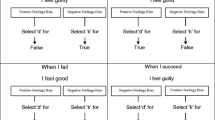Abstract
Twenty years of research into sex offenders' cognitive distortions has primarily focused on the measurement of distortions rather than on theorizing about the underlying structures that are responsible for generating and organizing them. Recently T. Ward (2000; T. Ward & T. Keenan, 1999) suggested that offenders have underlying causal theories about themselves, their victims, and broader categories of people (e.g., women and children), and that these implicit theories enable post hoc explanation as well as prediction of people's actions and reactions. D. L. L. Polaschek and T. Ward (2002) examined rape-related attitudinal scales and constructed and outlined five core implicit theories. Here, we examined whether evidence for these five theories was also found in offense process descriptions generated from interviews with 37 imprisoned rapists. Coding of the descriptions revealed support for all five theories.
Similar content being viewed by others
REFERENCES
Abel, G. G., Gore, D. K., Holland, C. L., Camp, N., Becker, J., & Rathner, J. (1989). The measurement of the cognitive distortions of child molesters. Annals of Sex Research, 2 ,135–153.
Beech, A., & Mann, R. (2002). Recent developments in the assessment and treatment of sexual offenders. In J. McGuire (Ed.), Offender rehabilitation and treatment: Effective programmes and policies to reduce re-offending (pp. 259–288). Chichester, UK: Wiley.
Burt, M. R. (1980). Cultural myths and supports for rape. Journal of Personality and Social Psychology, 38 ,217–230
Bush, J. (1995). Cognitive self-change: A program manual. Burlington: Vermont Department of Corrections.
Bushman, B. J., & Geen, R. G. (1990). Role of cognitive-emotional mediators and individual differences in the effects of media violence on aggression. Journal of Personality and Social Psychology, 58 ,156–163.
Check, J. V. P., Malamuth, N. M., Elias, B., & Barton, S. A. (1985). On hostile ground. Psychology Today, 19(4), 56–61.
Fleiss, J. L. (1981). Statistical methods for rates and proportions (2nd ed.). New York: Wiley.
Knight, R. A. (1999). Validation of a typology for rapists. Journal of Interpersonal Violence, 14 ,303–330.
Knight, R. A., & Prentky, R. A. (1990). Classifying sexual offenders: The development and corroboration of taxonomic models. In W. L. Marshall, D. R. Laws, & H. E. Barbaree (Eds.), Handbook of sexual assault: Issues, theories, and treatment of the offender (pp. 23–52). New York: Plenum.
Kuhn, D. (1989). Children and adults as intuitive scientists. Psychological Bulletin, 96 ,674–689.
Malamuth, N. M., & Brown, L. M. (1994). Sexually aggressive men's perceptions of women's communications. Journal of Personality and Social Psychology, 67 ,699–712.
Malamuth, N. M., Heavey, C. L., & Linz, D. (1993). Predicting men's antisocial behavior against women: The interaction model of sexual aggression. In G. C. N. Hall, R. Hirschman, J. R. Graham, & M. S. Zaragoza (Eds.), Sexual aggression: Issues in etiology, assessment, and treatment (pp. 63–97). Washington, DC: Taylor & Francis.
Mann, R. E., & Beech, A. R. (2003). Cognitive distortions, schemas, and implicit theories. In T. Ward, D. R. Laws, & S. M. Hudson (Eds.), Sexual deviance: Issues and controversies (pp. 135–153). Thousand Oaks, CA: Sage.
Polaschek, D. L. L., & Hudson, S. M. (2004). Pathways to rape: Patterns in the offense processes of rapists and their rehabilitation implications. Journal of Sexual Aggression, 10 ,7–20.
Polaschek, D. L. L., Hudson, S. M., Ward, T., & Siegert, R. J. (2001). Rapists' offense processes: A preliminary descriptive model. Journal of Interpersonal Violence, 16 ,523–544.
Polaschek, D. L. L., & Ward, T. (2002). The implicit theories of potential rapists: What our questionnaires tell us. Aggression and Violent Behavior, 7 ,385–406.
Polaschek, D. L. L., Ward, T., & Hudson, S. M. (1997). Rape and rapists: Theory and treatment. Clinical Psychology Review, 17 ,117–144.
Ward, T. (2000). Sexual offenders' cognitive distortions as implicit theories. Aggression and Violent Behavior, 5 ,491–507.
Ward, T., & Keenan, T. (1999). Child molesters' implicit theories. Journal of Interpersonal Violence, 14 ,821–838.
Wellman, H. M. (1990). The child's theory of mind. Cambridge, MA: MIT Press.
Young, J. E. (1994). Cognitive therapy for personality disorders: A schema focused approach (Rev. ed.). Sarasota, FL: Professional Resource Press.
Author information
Authors and Affiliations
Corresponding author
Rights and permissions
About this article
Cite this article
Polaschek, D.L.L., Gannon, T.A. The Implicit Theories of Rapists: What Convicted Offenders Tell Us. Sex Abuse 16, 299–314 (2004). https://doi.org/10.1023/B:SEBU.0000043325.94302.40
Issue Date:
DOI: https://doi.org/10.1023/B:SEBU.0000043325.94302.40




